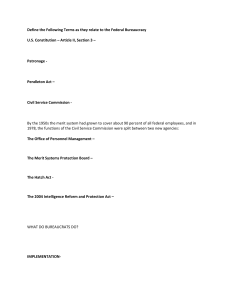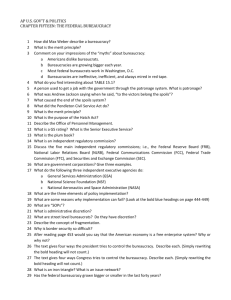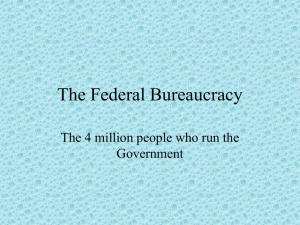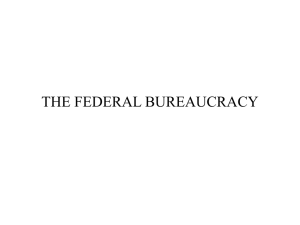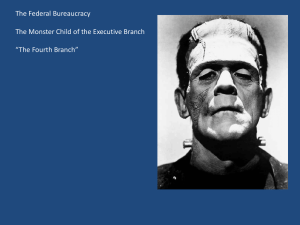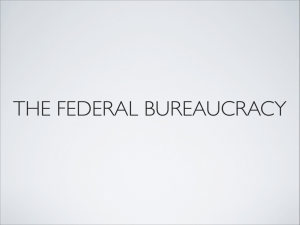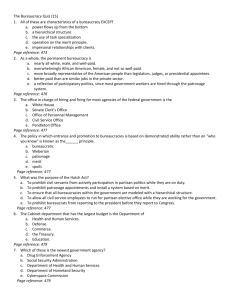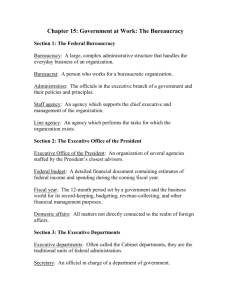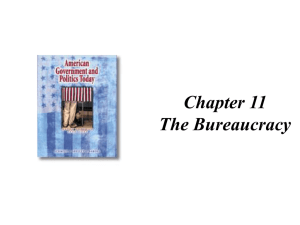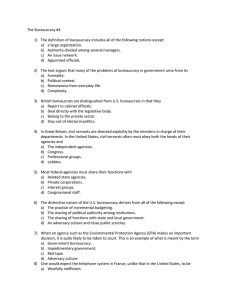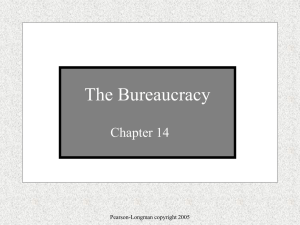Chapter 1
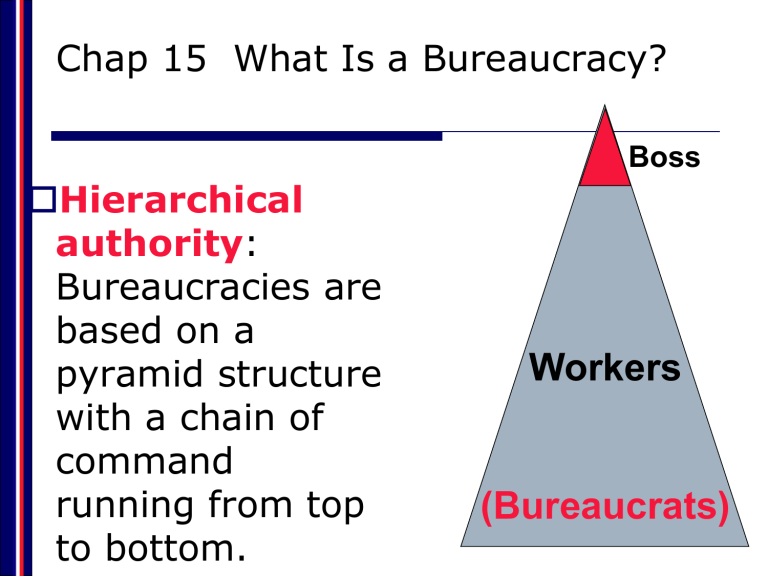
Chap 15 What Is a Bureaucracy?
Boss
Hierarchical authority :
Bureaucracies are based on a pyramid structure with a chain of command running from top to bottom.
Workers
(Bureaucrats)
The Executive Branch and the
Development of the Federal
Bureaucracy
Bureaucracy
A set of complex hierarchical departments, agencies, commissions, and their staffs that exist to help a chief executive officer carry out his or her duties.
Bureaucracies may be private organizations of government.
The Executive Branch and the
Development of the Federal
Bureaucracy
Modern bureaucracies, according to Weber, are characterized by:
A chain of command in which authority flows from top to bottom.
A division of labor whereby work is apportioned among specialized workers to increase productivity.
Clear lines of authority among workers and their superiors.
A goal orientation that determines structure, authority and rules.
Impersonality, whereby all employees are treated fairly based on merit and all clients are served equally, without discrimination, according to established rules.
Productivity, whereby all work and actions are evaluated according to established rules.
Growth in bureaucracy from 1789 to 1861
Spoils system
Post Office
Modern executive branch has 1.8 million civilian employees
Distribution of Federal Civilian
Employment
How to Fire a Federal
Bureaucrat
Civil War and the Growth of
Government
Civil War spawned need for new government agencies.
Department of Agriculture (1862)
Pension Office (1866)
Patronage
Jobs, grants, or other special favors that are given as rewards to friends and political allies for their support.
From the Spoils System to the
Merit System
Garfield’s presidency
Besieged by office-seekers (patronage seekers).
Wished to reform the system
Irony: assassinated by a frustrated job seeker.
Reaction to Garfield’s death and increasing criticism of the spoils system was the Civil Service Reform Act in
1883.
Also called the Pendleton Act
Reform measure that created the Civil Service
Commission to administer a partial merit system.
The act classified the federal service by grades to which appointments were made based on the results of a competitive examination.
It made it illegal for federal political appointees to be required to contribute to a particular political party.
Civil service system operated to 1978
New version is the merit system
Regulating the Economy and the Growth of Government in the 20 th Century
Growth of big business, price fixing, and other unfair business practices after the Civil War stimulated Congress to create the Interstate Commerce Commission.
First independent regulatory commission
An agency created by Congress that is generally concerned with a specific aspect of the economy.
Theodore Roosevelt
Department of Commerce and Labor
Woodrow Wilson
Divided it into two separate departments.
Encouraged Congress to create the Federal Trade
Commission.
Franklin Roosevelt
Hundreds of new government agencies due to the Great
Depression
Lyndon Johnson
War on Poverty created additional growth in the bureaucracy
Government Workers and Political
Involvement
Hatch Act
Law enacted in 1939 to prohibit civil servants from taking activist roles in partisan campaigns.
Could not make political contributions, work for a political party or campaign for a particular candidate.
Federal Employees Political Activities Act
1993 liberalization of the Hatch Act.
Allowed federal employees to run for office in nonpartisan elections and to contribute money to campaigns in partisan elections.
The Modern Bureaucracy
Bureaucrats
1.8 million federal workers not including postal and uniformed military personnel.
Most are selected by merit standards (civil service or foreign service exams, for example)
Tests usually for entry level positions.
10 percent of federal workforce not covered by civil service.
Appointive policy-making positions (cabinet secretaries, for example)
Independent Regulatory Commissioners
(appointed by the president)
Low-level, non-policy patronage positions.
Secretarial assistants to policy makers, for example.
Formal Organization
Cabinet Departments
Major administrative units with responsibility for a broad area of government operations.
Indicates a permanent national interest.
Government Corporations
Businesses established by Congress that perform functions that could be provided by private businesses.
Example: Amtrak, Federal Deposit Insurance Corporation.
Independent Agencies
Governmental units that closely resemble a Cabinet department but have a narrower area of responsibility and are not part of any Cabinet Department.
Example: Central Intelligence Agency
Independent Regulatory Commissions
Agencies created by Congress to exist outside the major departments to regulate a specific economic activity or interest.
Example: Federal Reserve Board.
The President’s Cabinet
How the Bureaucracy Works
Implementation
The process by which a law or policy is put into operation by the bureaucracy.
Iron triangles
Relatively stable relationships and patterns of interaction that occur among an agency, interest groups, and congressional committees or subcommittees.
Issue networks
The loose and informal relationships that exist among a large number of actors who work in broad policy area.
Increasing complexity of policy domains
Interagency councils
Making Policy
Administrative discretion
The ability of bureaucrats to make choices concerning the best way to implement congressional intentions.
Rule making
A quasi-legislative administrative process that has the characteristics of a legislative act.
Regulations
Rules that govern the operation of a particular government program that have the force of law.
1946 Administrative Procedures Act
Public notice of time, place and nature of rulemaking proceedings provided in the Federal
Register.
Submission of written arguments
Statutory purpose and basis of rule to be stated.
Once rule is written, 30 days must elapse before they take effect.
How a
Regulation is Made
Insert Figure
9.5 here
Making Policy
Administrative adjudication
A quasi-judicial process in which a bureaucratic agency settles disputes between two parties in a manner similar to the way courts resolve disputes.
Making Agencies Accountable
Executive Control
Executive orders
Rules or regulations issued by the president that have the effect of law.
Congressional Control
Constitutional powers
Power of the purse
General Accounting Office, Congressional
Research Service, and Congressional Budget
Office
Judicial Control
An Iron Triangle
Making Agencies Accountable
Frequency and Effectiveness of Oversight
Techniques in a Single Congress
